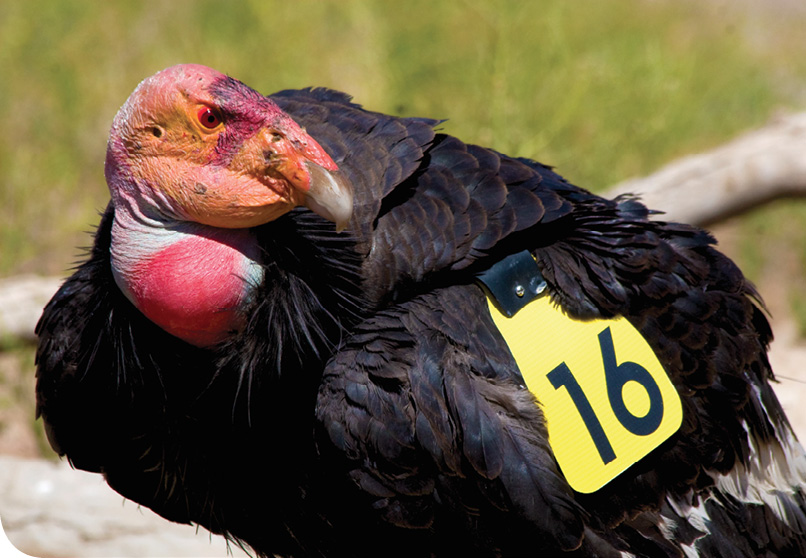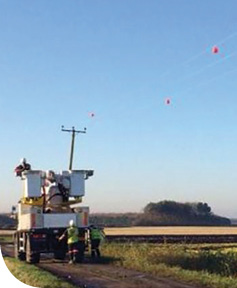The wind industry gets little credit for its great effort to protect wildlife of all kinds, probably because the effort goes under reported. That work includes the radar detection of approaching birds, controls that change a turbine’s start and stop times, and more.
Paul Dvorak, Editor
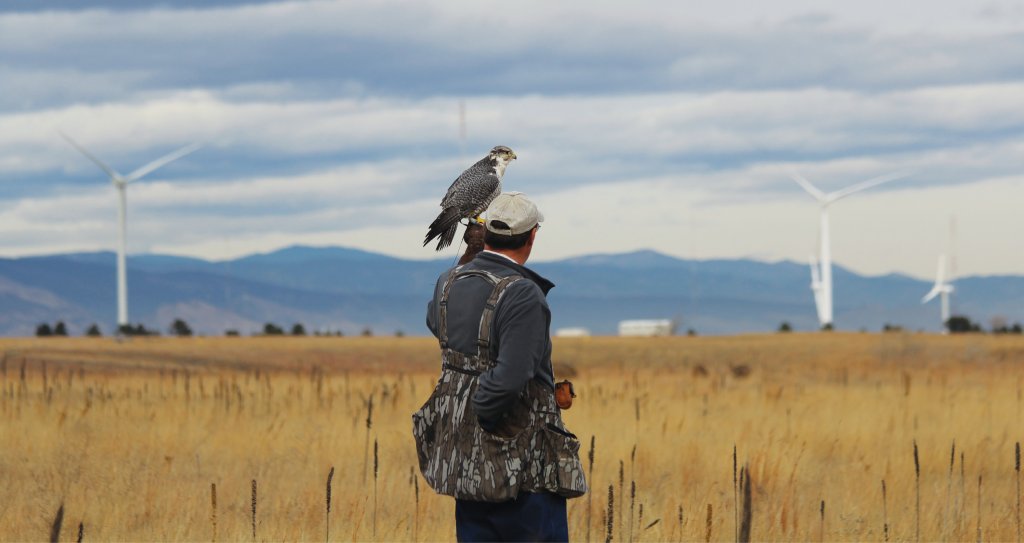
Falconer and friend get ready to test Lauffer’s radar. With sample signals, processing specialists might tell more about wildlife behavior over wind farms and from that, devise mitigation strategies.
The American Wind Energy Association acknowledges that eagle fatalities do occur at wind-energy facilities, but they are rare. AWEA’s reports that less than 2% of all anthropogenic golden eagle losses in the U.S. annually occur at modern wind farms, and in the history of the U.S. wind industry, only a handful of bald eagles have been lost. Despite this minor impact, the wind industry is doing more than others to find ways that further lower the accidents.
A few laws provide impetus to lower the figure as much as possible. For instance, a take – the accidental fatality of a protected animal – is in violation of the Migratory Bird Treaty Act and punishable with a fine of up to $15,000. That encourages wind-farm owners and operators to stay on the right side of the law.
But birds and bats, like children, just don’t know where they should not be. So owners and operators are working with a variety of companies to alert themselves when avian wildlife approaches their plants with the goal of warning the animals away. What follows are the devices and ideas, some ready for prime time and some not, that will keep birds from coming to harm.
A eye for eagles
Eagles, condors, and bats lead a precarious life. In the 1960s, DDT and dioxin was unkind to their populations. Once authorities recognized the hazard, legislation limited use of the chemicals and the bird populations rebounded. More recently, wind turbines, among other modern devices, have been responsible for an occasional eagle or buzzard death.
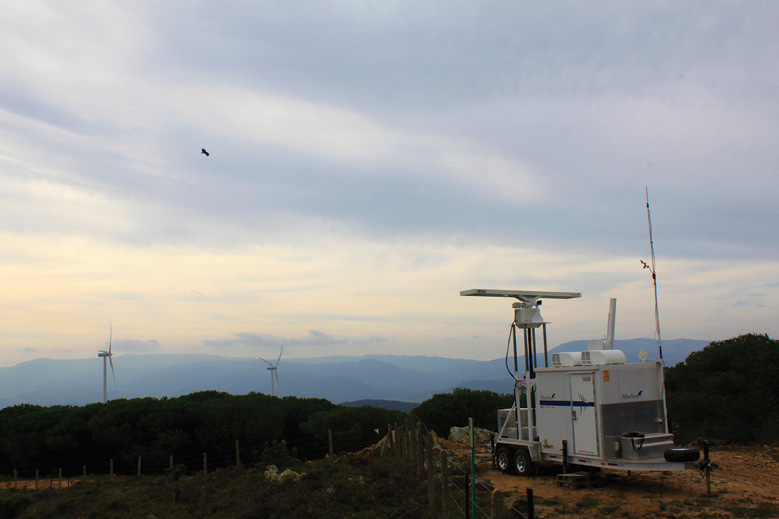
Bird radars from DeTect can spot targets approaching wind farms and send notice of them to people in the field who might decide on a next step, such as curtailing a turbine.
One reliable way to spot eagles in the vicinity of wind farms uses human sentries. Naturalists say that migrating eagles are looking ahead of themselves – where they are going. But hunting birds are looking down, and that is the telltale sign. One recent program using spotters worked quite well. When hunting eagles were spotted in the vicinity of a turbine, the machine was curtailed and the impact problem avoided.But human spotters are expensive and prone to distractions. Could there be a better way?
Large birds present mitigation challenges for which radar-based detection systems may have solutions. One company, DeTect Inc, manufacturers avian radar systems for detecting birds where they pose a risk, such as airports, wind farms, and oil-and-gas facilities. Each unit has costs and benefits depending on the project and what users are trying to detect.
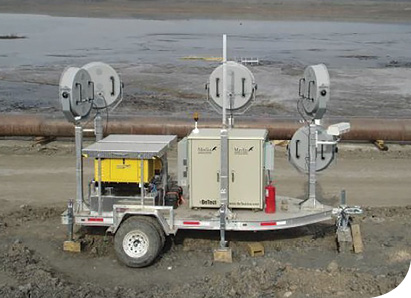
DeTect sound makers, a CNRL Merlin detect and deter system, are activated by avian radar (not shown). This unit is working at a pond in Fort McMurray, Alberta, Canada.
“Spotting approaching aircraft is one thing but identifying a bird species is another matter,” says Karen Voltura, Director, Wind Energy Systems with DeTect. The radar systems are capable of spotting a target bird moving into an area and evaluating its risk based on speed, direction, and distance to a wind turbine. Voltura says the MERLIN avian radar system can integrate signals and data from a variety of sources, such as SCADA systems and met towers, along with acoustic or bat monitors, even infared beam-break systems that count bats leaving a roost. That data is used to develop an algorithm which calculates a risk level upon which an operator can take action.
Voltura says most of her work has been with deterrents at mines and oil-and-gas fields, but the experience is instructive. Bird-control radar there detects birds in areas with non-water ponds that could be hazardous to birds. The systems can then set off deterrents. “We use a lot of long-range acoustic devices, equipment intended for crowd control. Sound generators can play multiple sounds at different levels. These are extremely loud and somewhat directional with about a 30° beam. We mount them in an array that depends on the target,” she says.
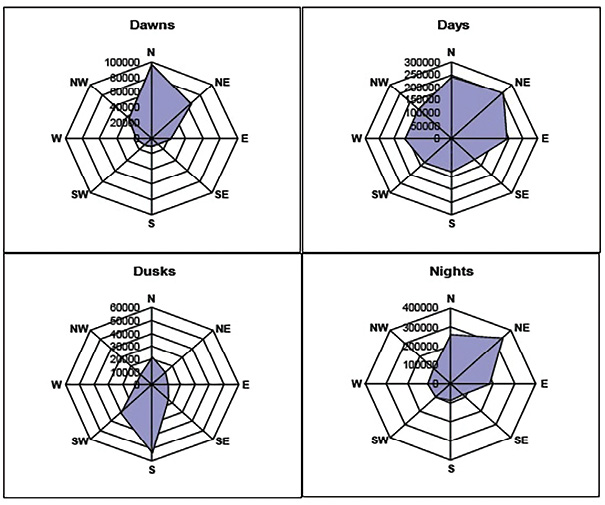
The shaded areas on the spider-web graphs, generated by DeTect’s Merlin SQL, indicate the presence of avian wildlife at different times of day. The units indicate a number of birds.
“A tactic would be to start with one sound and escalate it, which is necessary for wildlife control so birds don’t habituate to it. This happens when the sounds go off at regular intervals, such as propane cannons that boom every 20 minutes. Birds habituate to them. A better way sounds the noise only when a target is in-bound to that sector,” says Voltura.
For the ponds, the company uses physical or visual deterrents, popup effigies activated by radar. “We call them ‘scary man.’ You’ve seen the silly air-filled characters waving around at car lots. Ours are similar but are made to look like employees to scare the birds, so the characters have the same vests and caps. It works in combination with other things. We have tested a lot of visual deterrents but the acoustical devices and lasers are still primary.”
Wind farms, however, present special challenges. For instance, different bird species behave differently. Even individual birds of the same type react differently to a deterrent. So the challenge is avoiding habituation and that calls for a pretargeted deterrent.
What’s more, there is some question about what kind of things eagles can see. “It is now thought that they cannot see ultraviolet so UV deterrents are not going to be effective. But the jury is still out on that idea. Furthermore, harassing a migratory bird is also frowned upon and may require a permit,” says Voltura.
For wind farms, the approach would be to establish a barrier on the perimeter to keep birds out. Consider the bird that has flown to the interior of a wind farm. Turning it from one turbine risks the possibility of scaring it into another. So keeping them out of the wind farm is most logical.
“To that end, radar displays can be customized for a biological observer and let that person make a decision. A project in Spain works this way,” she says. A signal from a web-based display can be sent to people in the field with a tablet or to operators who might follow a set of rules to curtail a turbine. The action taken depends on the mitigation options.
Companies such as Laufer Wind are working to reduce bird deaths from wind farms based on its success with an aircraft-radar sensor. This device turns obstruction lights on when the system detects approaching aircraft in the vicinity of a wind farm. When the plane passes and is no longer in the vicinity, the obstruction lights turn off. “The system sets up a perimeter to protect the wind farm in a way that does not annoy nearby residences with constant night light,” says Lauffer Wind CEO Eric Lauffer. “With that radar experience, we are now interested in protecting raptors by building on an installation and test agreement with NREL that has let us demonstrate the aircraft detection systems to the FAA. The bird research includes detection and tracking of drones that have a similar cross section to the birds of interest,” he adds.
Recent tests with trained falcons instrumented with GPS loggers have let Laufer’s team record data that is later correlated with radar-track information. “Initial flight tests have been done with the raptor but we are still testing. The results will let us develop and tune the bird-tracking algorithms,” adds Laufer.
The next step is up to the software developers and system engineers to devise and refine tracking algorithms for birds. “Then we’ll collect more data and experience to build confidence in our solution,” says Lauffer.
Condors
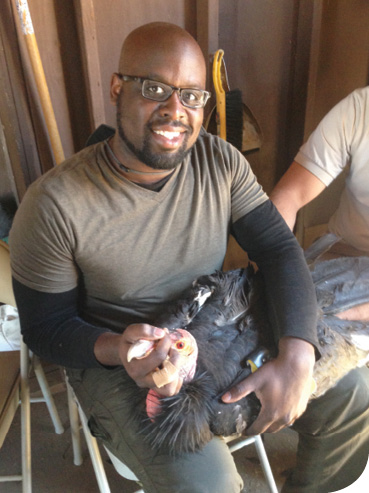
Professor Jonathan Hall instruments a condor to start a recently funded study that will track flight patterns of the birds.
Wind turbines and California condors could be a hazardous combination for the rare birds because they cannot quickly respond to aerial threats. Jonathan Hall, assistant professor in the Department of Geology and Geography at West Virginia University and colleague Dr. Todd Katzner, Research Wildlife Biologist at the Forest & Rangeland Ecosystem Science Center of the U.S. Geological Survey, are hoping to alleviate the problem by monitoring the flight patterns of condors. The year-long study is possible with a grant from the National Fish and Wildlife Foundation.
The project objective is to understand condor flight patterns and behavior, and how they respond to landscape and weather, all in an effort to mitigate potential impacts of wind farms and turbines. “There are only about 235 free-flying condors, so the plan is to prevent collisions between reintroduced birds and wind turbines,” says Hall. He and Katzner say they are unaware of any condor takes, but there is concern because of the small and slow-growing population.
The technology that Hall and Katzner will be using has progressed significantly since the 1970s. It went from VHS radios, to directional antennas, satellite tracking, and solar-powered GPS today. So instead of a few data points a day, the two will collect data on 15 tagged birds as often as every 30 seconds per bird. “As of September 2014, we have 15 units on birds. The units record GPS location, altitude, flight speed, and temperature every 15 minutes and transmit the data by cell-phone networks to a remote server,” says Hall.
The amount of data will provide a much clearer picture of condor flight behavior. “As we dig into the data, we expect to see more useful patterns. For instance, condors fly at different altitudes depending on the landform and ground cover. That has an impact on their vulnerability to a turbine and may prove useful in siting turbines to minimize risk,” says Katzner.
Hall suggests waiting and seeing what condor behavior, weather, and topography reveal before they make recommendations to wind farm owners. However, one goal of the study is to build a map that identifies relatively safe locations for building a wind farm. “So a developer should be able to tell us where he’d like to build a wind farm and we should be able to tell if individual turbines are in good or bad locations, from a condor’s perspective,” adds Katzner.
Bats
Why bats are attracted to wind turbines is still a matter of speculation. “Research to answer that question is ongoing,” says Delaware State University Professor Kevina Vulinec. “One thought is that bats see the turbine as a large tree in which to roost and eat what they may have caught. Bats may also use turbines as a landmark for mating swarms. Or, they may think it’s a place to spend the day, having been out all night. In fact, day and night, bats that notice a turbine may very well investigate it. However, none of the hypotheses proposed to explain bat behavior around turbines have been proven. We do know that bats appear to make approaches to turbines more than just random flybys.” At the university, scientists are dealing mostly with the Eastern Red bats, Hoary bats, Silver-haired bats, and Big brown bats.
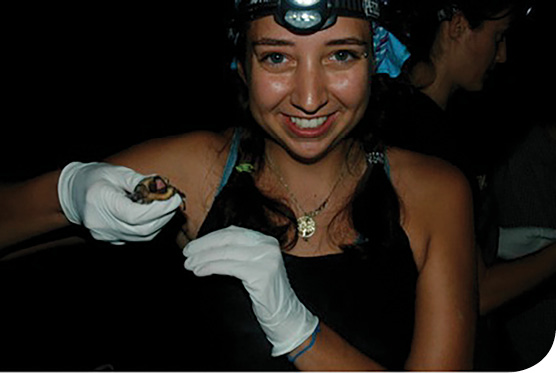
You’re in good hands with Megan. Ms. Wallrichs, a student of Professor Kevina Volinec, holds a Hoary bat, one common to the area around the University of Delaware.
Wind turbines and bats have probably not mixed well because the blades move too fast for the echolocation to warn the animals of their approach. “Bat sonar reaches out about 3 ft. when chasing prey and can reach 20 to 40 ft to check out the space ahead.
“Also, unlike small rodents, most bats give birth just once a year so their populations grow slowly. A few species, such as red bats, can have up to three young, but that is unusual,” says Vulinec.
Such a slow population growth makes finding deterrents all the more important. “Some researchers are looking into ultrasonic warning calls which theoretically would warn bats away from turbines. But again, that research is experimental,” she adds. This year Vulinec’s team put up four microphones around a Gamesa turbine but data on that effort is not yet available.
A shield for bats
Not long ago, wildlife experts at University of Delaware (UD) and Delaware State University launched a research program to understand the impact of wind turbines on bats. First State Marine Wind, a joint venture between the University of Delaware and Gamesa which owns a G90-2.0 MW turbine installation on the UD campus, funded the research through their R&D committee. “Part of the research being conducted is to find out why bats are attracted to wind turbines,” says Gonzalo Palacio, the resident engineering director at Gamesa’s North America headquarters. So far the team has observed more bat activity near the turbine and less farther away. “Looking for clues, we installed acoustic sensors, one about 200m away from the turbine and another next to the tower, about 18m up.” The acoustic signals tell them the bats are not feeding. “So they are not going to the turbine for insects. Some research suggests the turbines appear as a place to roost,” adds Palacio.
Since 2011, the University has been interested in studying bat strikes by wind turbines and how turbines could affect bat migration patterns. The university picked up the study because it has a good research program in renewable energy and it wants to understand how turbines affect the environment and wildlife. “Gamesa has always been interested in that too, so the project is a win-win for both organizations,” he adds.
From this cooperation and previous research, the company provided the scientists with BatShield, Gamesa-developed software, to aid in the study. Essentially, it is control software that considers time of day and year, temperature, wind speed and direction, and other factors. Programmed to account for circumstances that indicate the likely presence of bats, the software will trigger a delay in the start of a halted turbine or curtail its operation to protect the animals.
BatShield is programmable with different variables, which allows a response tailored for the local conditions. “Knowing the relevant conditions and the period for which those conditions are met might indicate a situation in which a few turbines on a wind farm have bats in their vicinity. So only those few turbines would be curtailed. Each turbine on a farm can be controlled independently,” says Palacio.
Based on those parameters, the turbine control system would make sure only those turbines in the relevant locations are curtailed and BatShield is deployed only in the turbines corresponding to the migration patterns. The software can be loaded and adapted remotely. “This ensures that turbines not in the vicinity of bat movement can continue to produce power normally. Our two goals are to minimize bat impacts and to maximize power production,” adds Palacio.
Results have been positive. “We have data on bat activity at the University from 2011 and 2012 without BatShield. In 2013 we installed BatShield and tested it by turning it on for a week and off for a week. We saw significant results. The last campaign, we saw a 90% decrease in bat strikes when BatShield was used. We are still trying to understand the remaining 10%, but we are pleased with the remarkable decrease,” he adds. Gamesa continues work with several wind farms and UD to further improve the product.
LARGE RED BALLS MAKE POWER LINES VISIBLE TO BIRDS. A CLUE FOR WIND?
A report out of the UK says hundreds of special diverters, large red spheres attached to power lines, have saved migrating swans and geese from colliding with overhead power lines in Lancashire. The region’s power network operator, Electricity North West in partnership with Wildfowl and Wetlands Trust (WWT) Martin Mere Wetland Centre has seen a 50% reduction in power cuts caused by bird collisions after 150 bird diverters were attached to overhead power lines last winter in the area surrounding a WWT site.
As a result, engineers recently installed 200 more diverters along 2 km of overhead power lines to help raise the visibility for the 30,000 pink-footed geese and whooper swans that migrate to the area every year from Iceland.
Over the past year Electricity North West has sponsored a student from Lancaster University to analyze the efficiency of bird diverters. The study found that whooper swans rather than pink-footed geese were more likely to collide with power lines due to their flight path and there is an increased risk of collision when electricity lines are in an open landscape or close to surface water. The results from the study will be used throughout the North West and shared with other power operators across the country.
“Working closely with WWT Martin Mere, we’re set to install more diverters over the next year and will work to incorporate key findings from the study in our best-practice policies across the North West to help protect these wonderful birds,” said Steve Cox, head of engineering for Electricity North West in the UK.
Filed Under: Featured, News, O&M

